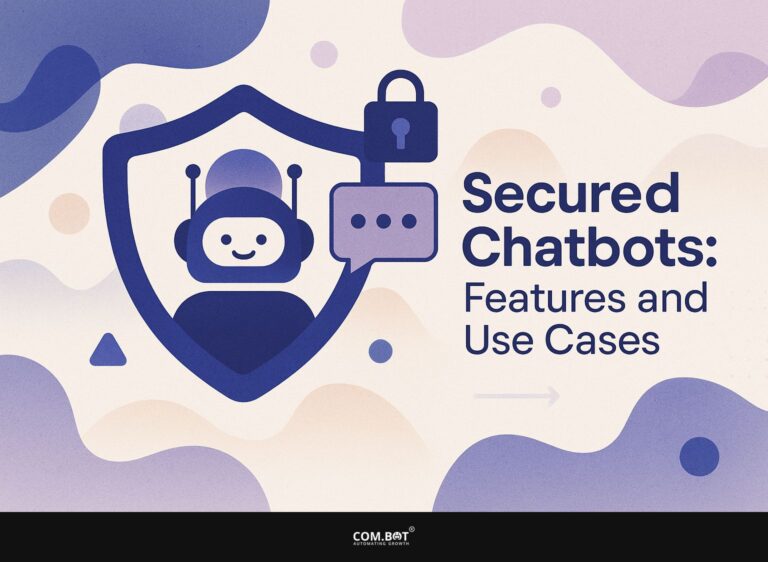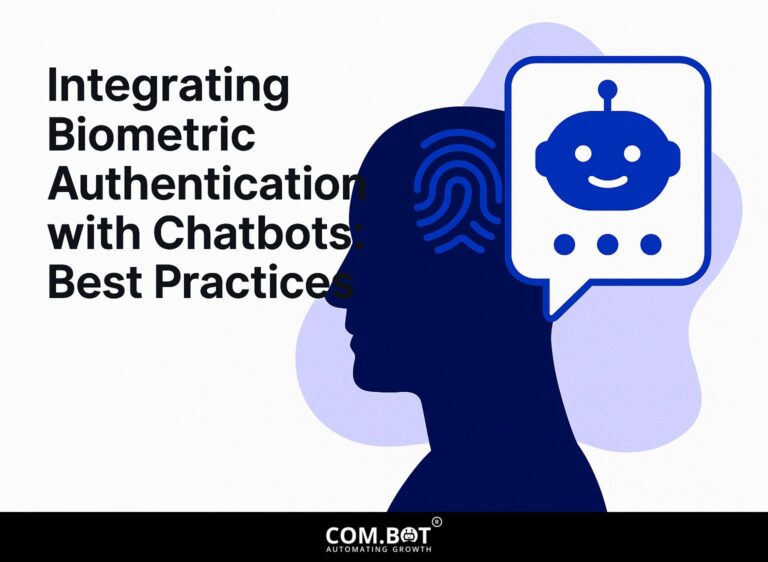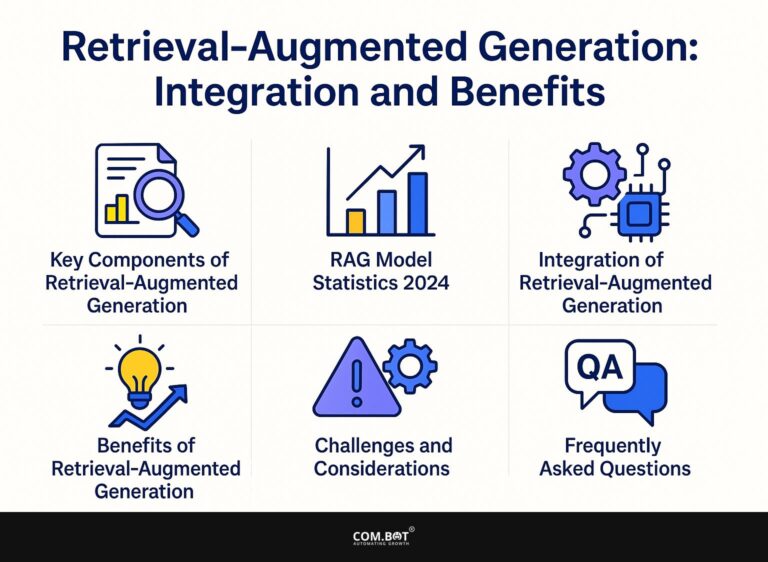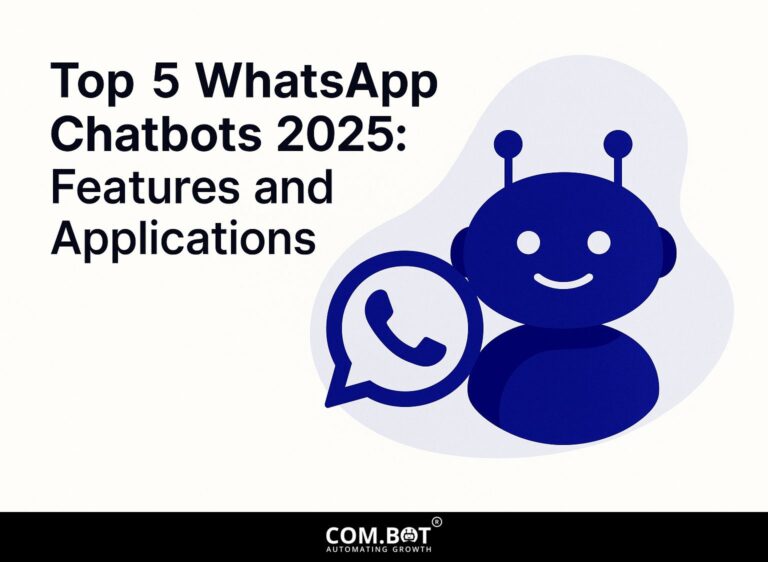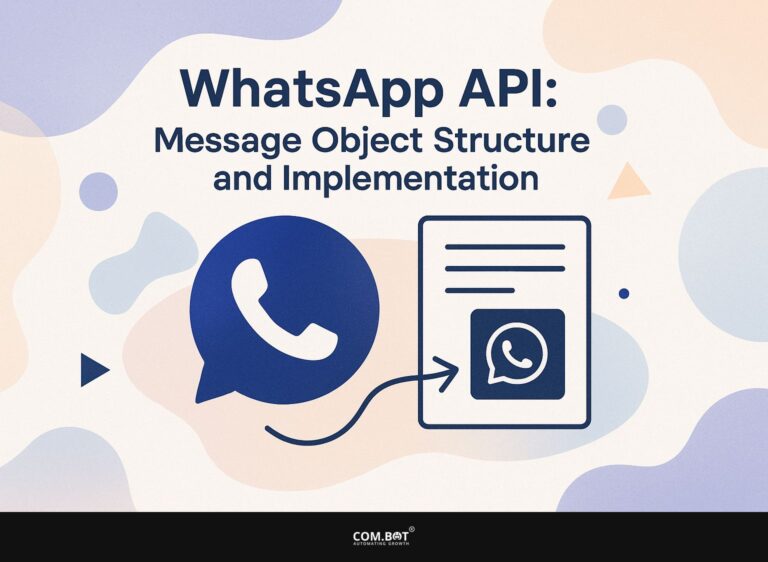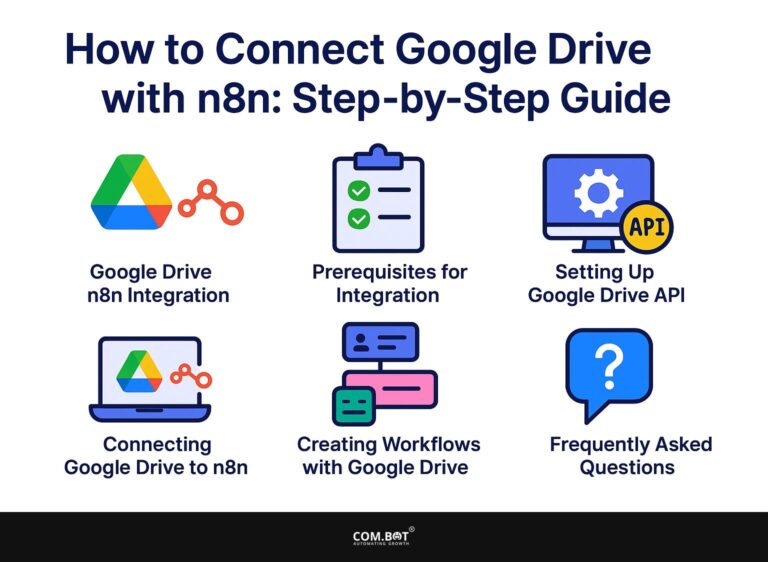How to Use AI WhatsApp Bots? Best Practices for US Businesses
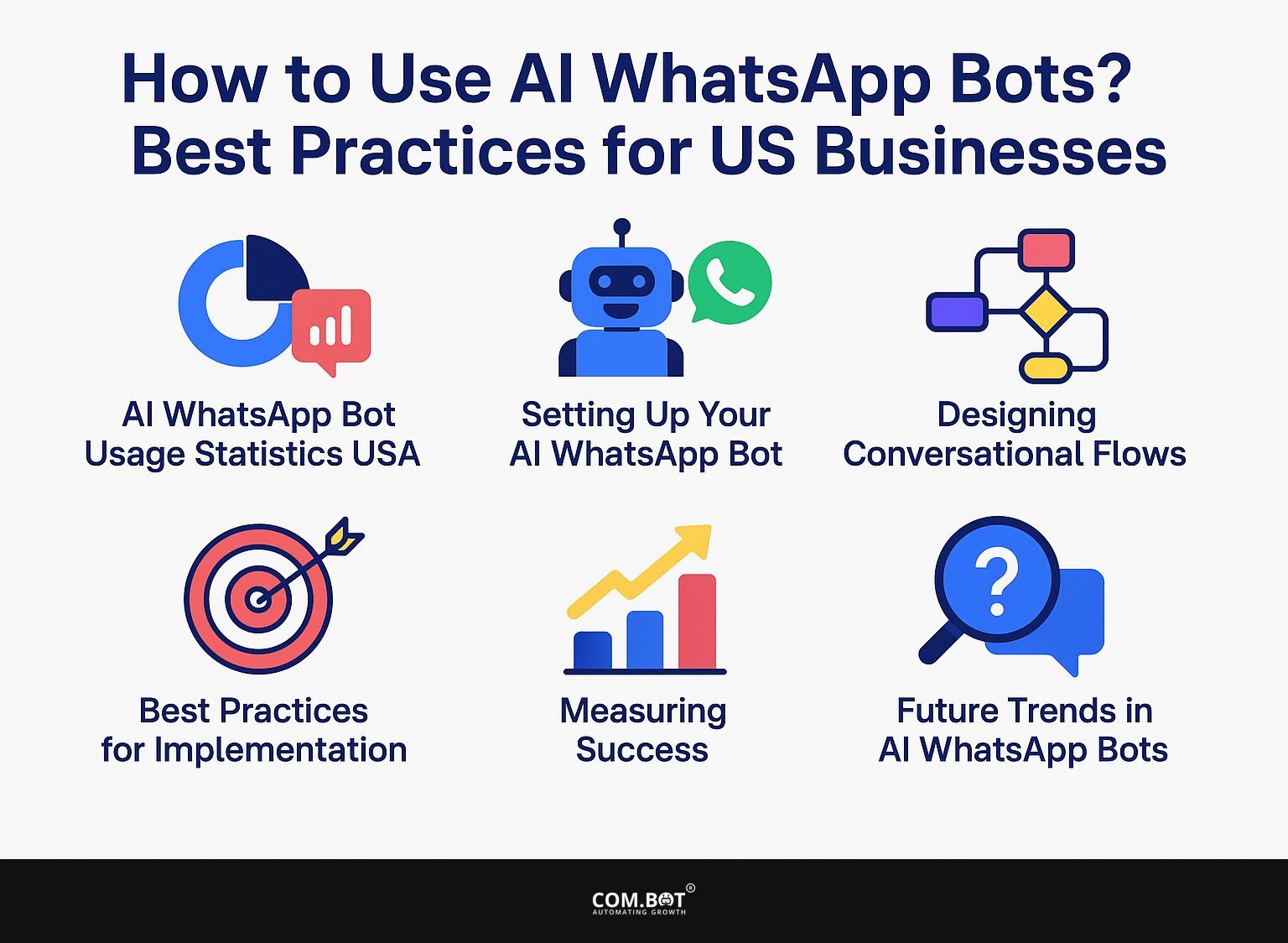
Good customer service is very important for US businesses. WhatsApp chatbots can help make interactions easier and faster. By using platforms like Aivo and Zendesk, companies can improve customer support while saving time and resources.
In this article, we’ll discuss practical methods to use AI WhatsApp bots to make customers happier and simplify tasks. Prepare to change how you interact with your customers!
Key Takeaways:
- An AI WhatsApp bot can support US companies by providing fast and personalized help to customers.
- When setting up an AI WhatsApp bot, choose the right platform and integrate with the WhatsApp Business API for smooth operation.
- Creating chat sequences that focus on knowing what the user wants and making interesting replies is important for a successful AI WhatsApp bot.
- 1 AI WhatsApp Bot Usage Statistics USA
- 2 Setting Up Your AI WhatsApp Bot
- 3 Designing Conversational Flows
- 4 Best Practices for Implementation
- 5 Measuring Success
- 6 Future Trends in AI WhatsApp Bots
- 7 Frequently Asked Questions
- 7.1 1. What are AI WhatsApp bots and how can US businesses use them?
- 7.2 2. What are the benefits of using AI WhatsApp bots for US businesses?
- 7.3 3. How can I start using AI WhatsApp bots for my US business?
- 7.4 4. What are some best practices for US businesses when using AI WhatsApp bots?
- 7.5 5. Can AI WhatsApp bots be used for marketing purposes by US businesses?
- 7.6 6. How can US businesses make sure their AI WhatsApp bots give a good user experience?
1. Definition and Purpose
AI WhatsApp bots are intelligent programs that handle chatting with people on WhatsApp, simplifying communication. These bots can manage customer questions using natural language processing, allowing them to give quick responses and help customers without needing a person.
For example, a retail bot can answer product questions, track orders, or facilitate returns. Tools such as Twilio or Landbot allow companies to create custom WhatsApp bots that make user interactions better.
By integrating AI-powered responses, companies can resolve common queries, reducing wait times and improving customer satisfaction. This automation helps save resources and lets customer service teams concentrate on more challenging issues. To gain a deeper understanding, our comprehensive guide on AI WhatsApp Bots explores various benefits and use cases.
2. Importance for US Businesses
For US businesses, using AI WhatsApp bots can lead to a clear increase in customer interaction, with studies showing up to a 30% increase in customer responses. These bots simplify communication by providing fast replies and custom responses based on user questions, leading to better customer satisfaction.
For instance, companies like Domino’s use AI bots for order tracking, leading to a 20% increase in repeat orders. Brands employing AI tools like Twilio or Chatbot.com report reduced operational costs by up to 40%, enabling better resource allocation.
Companies use these technologies to improve their communication with customers and build loyalty by offering fast service.
AI WhatsApp Bot Usage Statistics USA
AI WhatsApp Bot Usage Statistics USA
Integrating AI bots into customer interactions can greatly enhance user satisfaction and streamline processes. This approach aligns with the principles outlined in our analysis of AI Bots for Customer Support: Benefits and Satisfaction.
Chatbot Usage Highlights: Adoption and Usage
Chatbot Usage Highlights: Efficiency and Satisfaction
Chatbot Usage Highlights: Market Growth
The AI WhatsApp Bot Usage Statistics USA gives a clear summary of how chatbots are used in consumer and business communications, especially looking at how they are being used more, how well they work, how happy people are with them, and how the market is expanding. This information helps to see how people interact with chatbots and find methods to improve them over time.
Chatbot Usage Highlights show that 67% of consumers interact with chatbots This shows a strong acceptance of automated systems in customer service and support. Businesses have reported a 90% improvement in complaint resolution speed, showcasing the efficiency of chatbots in handling inquiries and solving issues. Banking interactions with chatbots present a smaller percentage, with 37.4% in 2022 and a projected increase to 40.8% by 2026, indicating gradual acceptance and usage in the financial sector.
- Efficiency and Satisfaction: Chatbots handle 80% of routine questions, highlighting their effectiveness in streamlining customer service processes. However, the same percentage of consumers says they are frustrated, probably because chatbots have trouble with hard questions and providing specific answers, showing that chatbots need to improve and handle more tasks.
- Market Growth: The chatbot market is projected to be worth $455 million by 2027, reflecting significant growth potential as businesses worldwide recognize the benefits of AI-driven customer interaction. Notably, 70% of Fortune 500 companies have adopted chatbots, showing the technology’s critical role in large-scale operations and competitive strategy.
The data on AI WhatsApp Bot Usage shows a hopeful but difficult situation. Chatbots are becoming more common and help save time, but there is a need for better options to make users happier and do more tasks. As the market grows, the focus will likely shift towards refining AI interactions to better meet consumer needs and expectations, driving further adoption and technological advancement.
Setting Up Your AI WhatsApp Bot
To build an AI bot for WhatsApp, select the right platform and link it with the WhatsApp Business API to handle customer messages automatically. For those interested in a comprehensive guide to setting up such a bot, consider our complete step-by-step guide on creating a WhatsApp AI Chatbot.
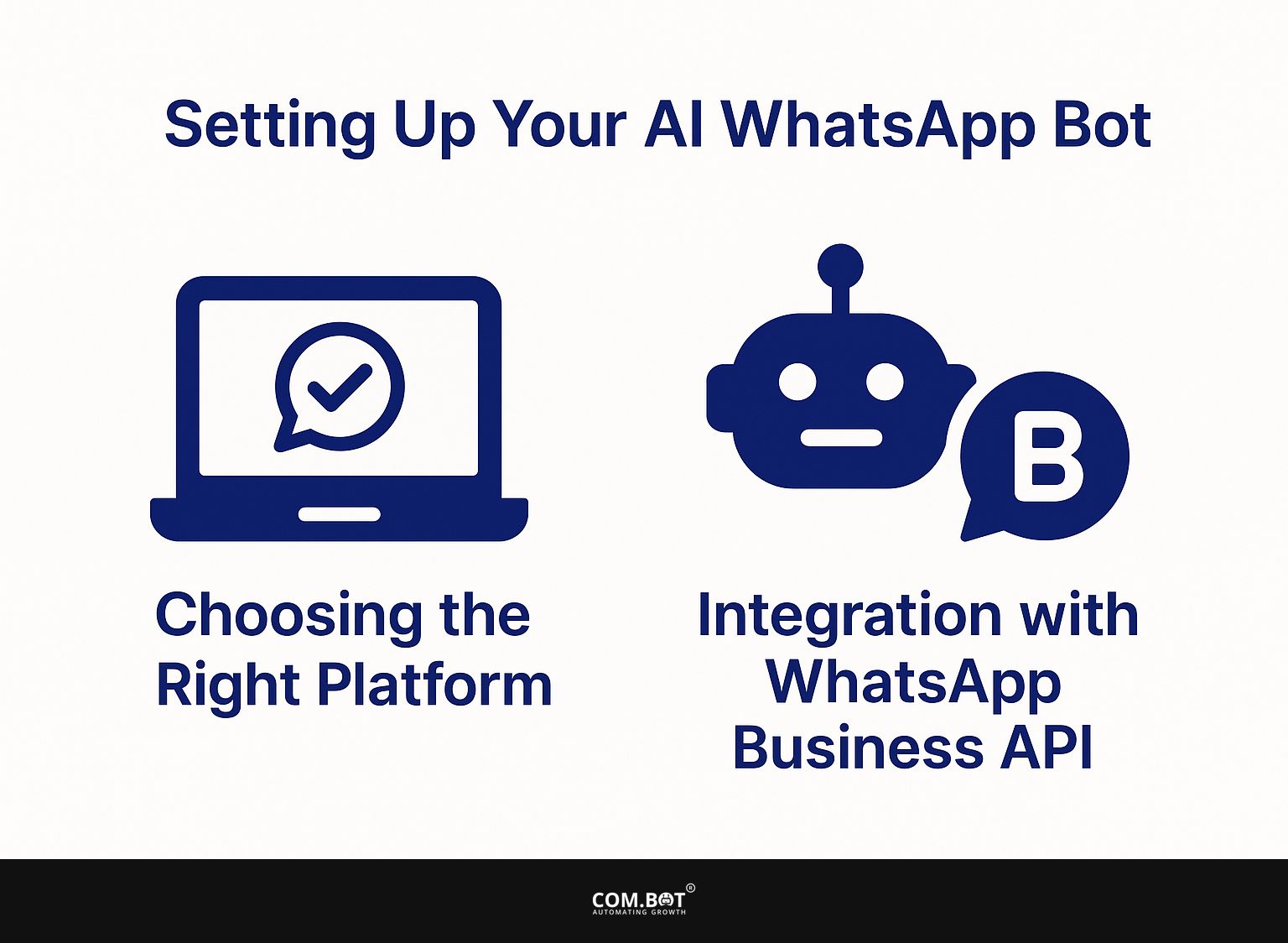
1. Choosing the Right Platform
Selecting the right platform for your AI WhatsApp bot is critical, with options like Aivo, Zendesk, and Twilio catering to various business needs and budgets. Aivo focuses on helping businesses communicate with their customers. They provide strong tools starting at about $50 per month, ideal for small businesses.
Zendesk, with its extensive support features, begins at $19 per agent/month and suits organizations needing additional helpdesk capabilities. Alternatively, Twilio offers a pricing plan where you pay for what you use, which is popular with developers looking for large-scale customization.
Assess your business size, budget, and specific communication needs to select the platform that aligns best with your goals.
2. Integration with WhatsApp Business API
Integrating your chatbot with the WhatsApp Business API requires technical know-how and can cost between $200 and $500 depending on the complexity. To begin, make sure you have an official WhatsApp Business Account and a server to host your chatbot. Start by choosing a chatbot system such as Twilio or Dialogflow, which makes it easier to connect.
After setting up your API access, use webhooks to connect your chatbot to WhatsApp, allowing real-time communication. Check that your bot complies with WhatsApp’s messaging policies to avoid issues. Carefully testing your integration before launching can help stop possible problems that might affect how users interact with it.
Designing Conversational Flows
Creating clear and helpful conversation paths is important for increasing user participation and directing discussions towards desired outcomes.
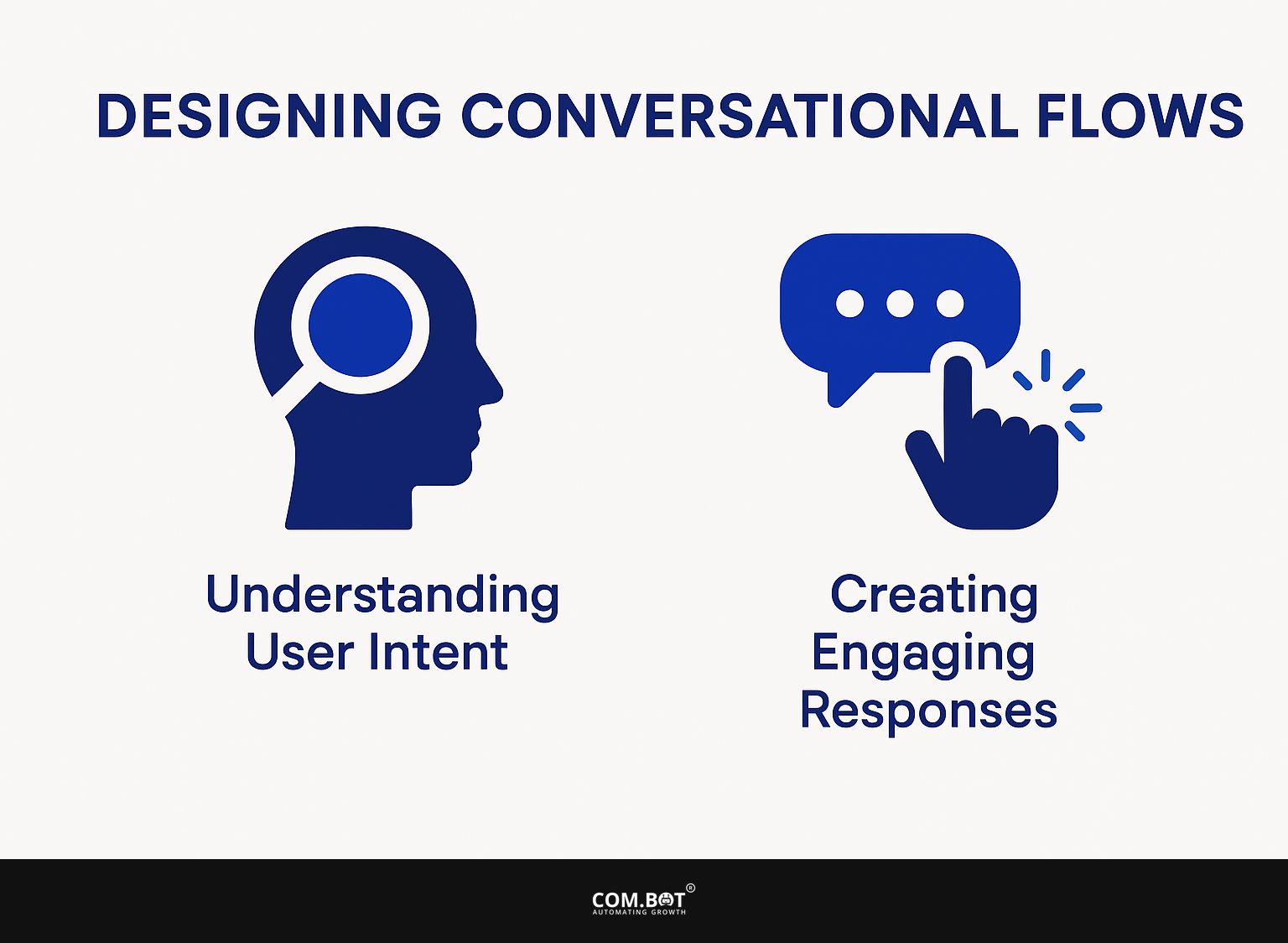
1. Understanding User Intent
For successful interactions, companies must clearly identify users’ needs. This can be done by analyzing data and using feedback loops.
Utilizing tools like Google Analytics allows businesses to track user behaviors, such as page visits and time spent on specific sections. This information shows which subjects connect best with users.
Asking users for their feedback can reveal what they like and want. To find the best approach, try A/B testing different conversation scripts to see which works better in real-time. Regularly updating the information from these methods helps keep conversations engaging and helpful.
2. Creating Engaging Responses
Creating interesting replies is important for keeping users involved, and using templates can make this process easier while still allowing for personal touches.
To improve your replies, try using templates that you can change as needed, like:
- “Thank you for your question, [User Name]!”
- “I appreciate your interest in [Topic]. Here’s what I think…”
This makes the interaction unique to you and helps you connect quickly. Use user information to tailor responses, like referring to their previous interactions. Tools like Zendesk or Intercom offer options to track user history, allowing you to make responses that feel personal.
Best Practices for Implementation
To successfully use AI WhatsApp bots, follow best practices, make sure they meet users’ needs, and comply with legal requirements. Implementing these bots efficiently is crucial, especially when managing high user volumes; understanding their scalability and efficiency can greatly enhance user experience.
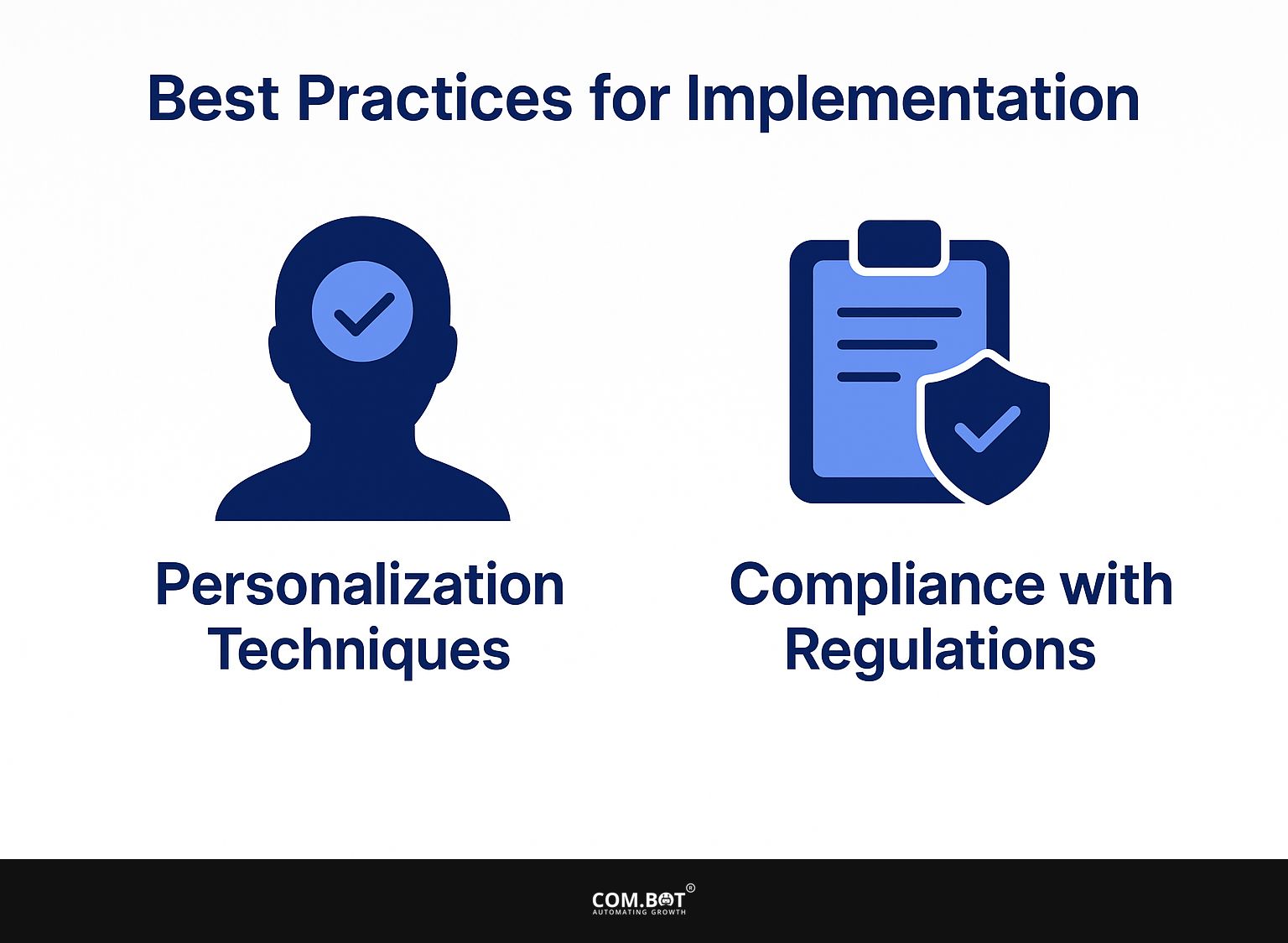
1. Personalization Techniques
Using personalization methods, like customizing messages with user information, can greatly improve how much customers interact.
For instance, start by analyzing user interactions to segment your audience effectively. Depending on their preferences, you can send custom greetings on special occasions, such as birthdays, increasing engagement by up to 30%.
Show different content that changes according to what someone bought before, highlighting products that match their interests. Tools like ManyChat help you use these methods easily. Some businesses report that custom messages have increased sales by 20%.
2. Compliance with Regulations
Following data protection rules like GDPR and CCPA is important for any company using AI WhatsApp bots. To do this, begin by reviewing the data to find out what personal information your bot gathers. Use tools like OneTrust or TrustArc to simplify compliance tracking.
Next, implement clear opt-in processes for user consent, providing transparency about data usage. Check your policies often and make sure your chatbot clearly shows where to find terms and privacy settings.
It’s wise to stay informed about rule changes by subscribing to industry newsletters or compliance forums. This helps your business remain updated as laws adjust.
Measuring Success
To assess the effectiveness of AI WhatsApp bots, it is important to set clear benchmarks that show how users engage with the bots and how well they function.
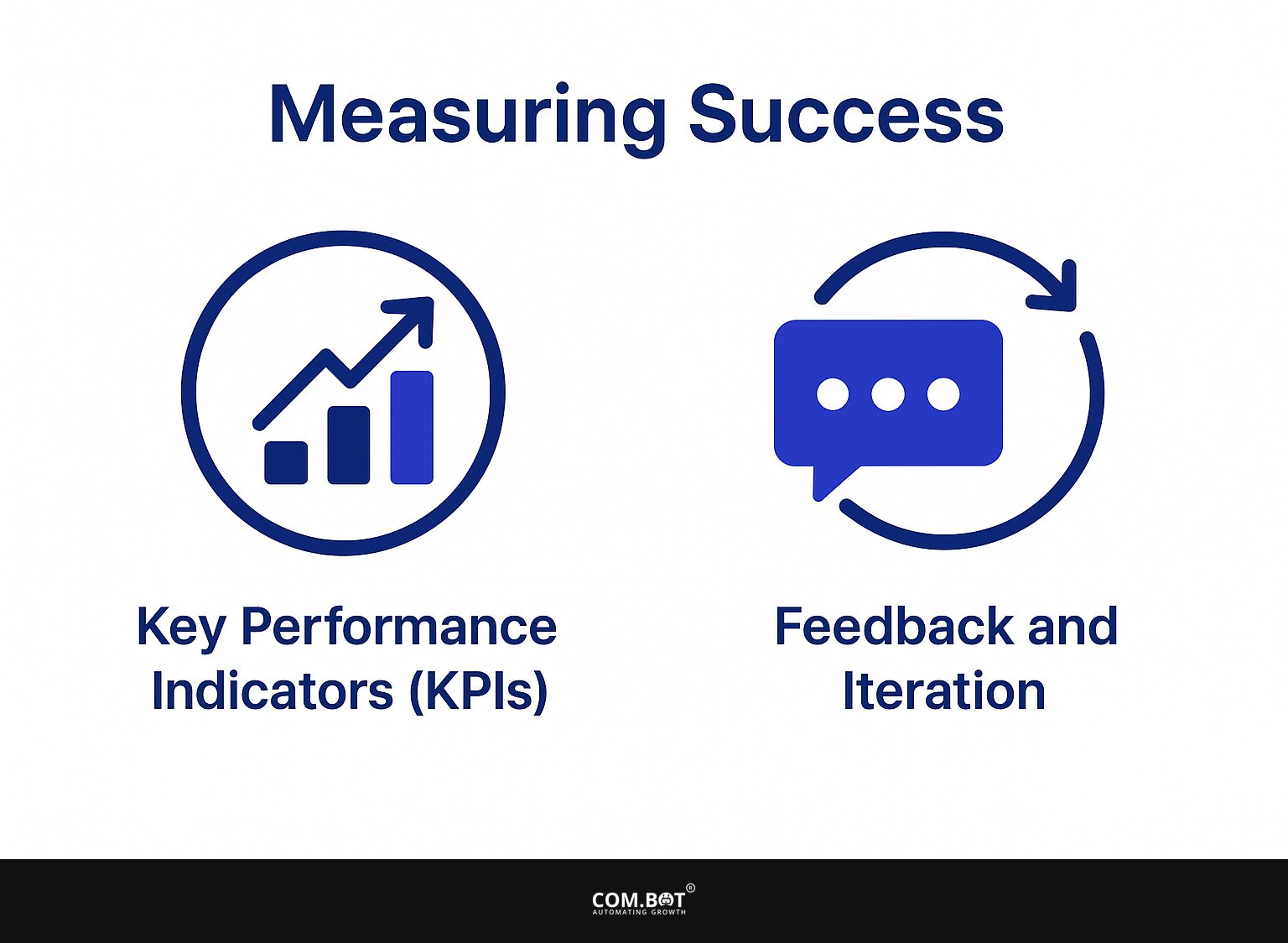
1. Key Performance Indicators (KPIs)
Key metrics such as average response time and customer satisfaction scores are important for assessing how well your AI WhatsApp bot is working. To monitor these KPIs well, use Google Analytics for user activity data and chatbot analytics services like Chatbase.
Set benchmarks by comparing your average response times against industry standards-typically, aim for under 30 seconds for optimal customer experience.
Regularly survey users after interactions to gauge satisfaction, striving for a score of 80% or higher. Analyze this data monthly to identify trends and areas for improvement in your bot’s performance.
2. Feedback and Iteration
Regularly gathering feedback from users and updating your AI WhatsApp bot can make it work better over time. To effectively gather user feedback, employ methods like surveys or direct conversations. Tools such as SurveyMonkey or Google Forms can help create user-friendly surveys to assess satisfaction and feature requests.
Make it possible for people to share their thoughts on recent conversations through WhatsApp messages. After collecting data, analyze trends and prioritize improvements.
For instance, if users often ask for faster answers, think about improving your bot’s natural language processing to make its chatting abilities better. This repeated method makes sure your bot keeps improving to match what users want.
Future Trends in AI WhatsApp Bots
The growth of AI WhatsApp bots is set to increase, with new technologies changing how customer service works in different industries. To enhance customer satisfaction, businesses are increasingly turning to AI bots for customer support, which offer numerous benefits.
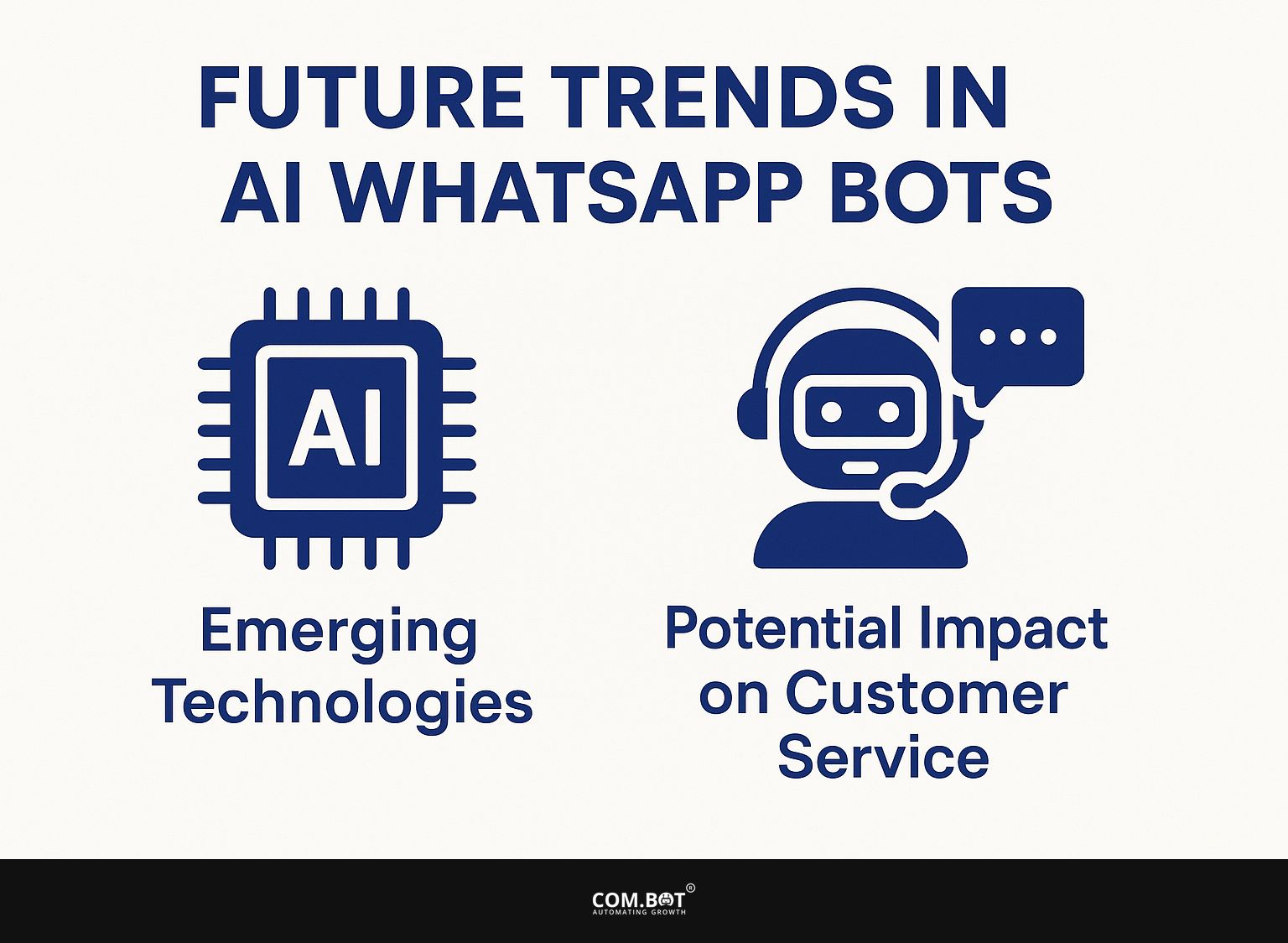
1. Emerging Technologies
Emerging technologies such as machine learning and natural language processing are enhancing the capabilities of AI WhatsApp bots for better user interactions.
These improvements allow for more detailed talks and custom user interactions. For example, machine learning algorithms can analyze user behavior to tailor interactions, while natural language processing allows bots to understand context and sentiment.
Right now, companies such as Chatfuel and Dialogflow are using these technologies to build bots that manage customer questions or make bookings smoothly. Later on, we could see more use of blockchain for data security, which would increase trust in transactions handled by AI bots.
2. Potential Impact on Customer Service
Adding AI WhatsApp bots to customer service is likely to greatly improve user experience and make operations run more smoothly. AI WhatsApp bots can manage many customer questions at once, cutting down response times.
For instance, a case study by Juniper Research found that businesses using AI chatbots can save up to 30% on customer support costs. Bots can operate 24/7, providing consistent support. Companies like MGI Digital use AI bots to answer up to 70% of customer questions without needing people.
This increases customer happiness and lets human agents deal with more difficult problems, which makes the service better.
Frequently Asked Questions
1. What are AI WhatsApp bots and how can US businesses use them?
AI WhatsApp bots are computer programs designed to simulate human conversation and interact with users on the messaging platform WhatsApp. US businesses can use these bots to handle tasks in customer service, sales, and marketing.
2. What are the benefits of using AI WhatsApp bots for US businesses?
AI WhatsApp bots can save US businesses time and resources by handling repetitive tasks and providing quick and efficient customer service. They can increase customer engagement and drive sales by personalizing conversations.
3. How can I start using AI WhatsApp bots for my US business?
To start using AI WhatsApp bots for your US business, you will need to choose a bot platform and create a bot account. You can then customize the bot’s conversation flow and integrate it with your existing systems and databases.
4. What are some best practices for US businesses when using AI WhatsApp bots?
One best practice is to clearly communicate with customers that they are interacting with a bot and not a human. It’s also important to regularly monitor and update the bot’s performance, as well as provide easy ways for customers to reach a human representative if needed.
5. Can AI WhatsApp bots be used for marketing purposes by US businesses?
Yes, AI WhatsApp bots can be a powerful tool for marketing for US businesses. They can send individual messages to customers, provide special offers and discounts, and collect customer opinions.
6. How can US businesses make sure their AI WhatsApp bots give a good user experience?
To provide a good experience for users, US businesses should create bots that are easy to use and well-planned. Testing and gathering feedback from customers can also help identify any issues and improve the bot’s performance. It’s also important to have a human team available to handle any complex or sensitive situations that the bot may not be able to handle.
